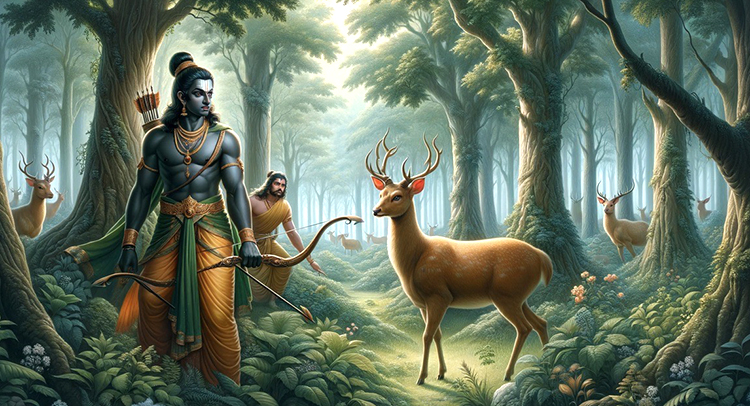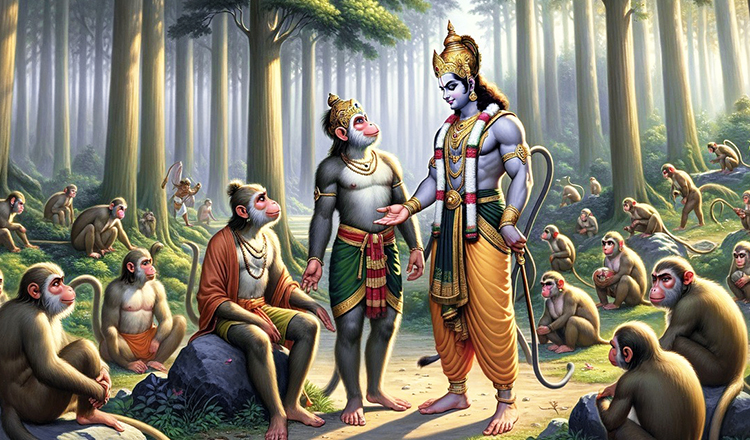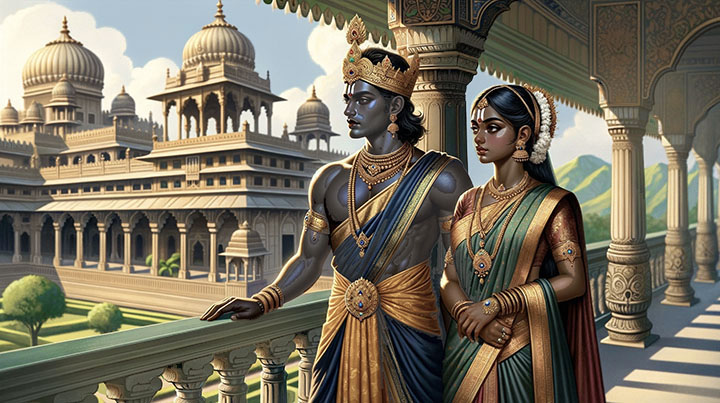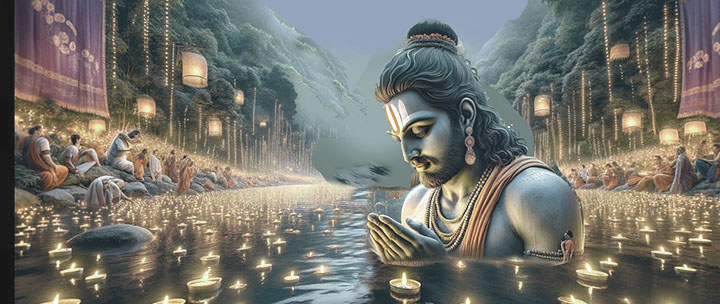Rama, Sita, Laxman exiled 14 years in the Forest.
Ayodya is the birthplace of Lord Rama and setting of the great epic Ramayana. One of the most significant places from Ramayana, Ram, Sita, and Lakshman were exiled from Ayodhya and spent years in exile at Chitrakoot. During their exile in the woods, Ram, Sita, and Lakshman walked from Chitrakoot to India’s huge Dandakaranya forest, according to the scripture. According to Ramayana, the trio spent 11 years in this forest.
The entire life story of Rama, Sita and their companions allegorically discusses duties, rights and social responsibilities of an individual. It illustrates dharma and dharmic living through model characters.

Chitrakoot forest where the Ramayana unfolded
Ram, while in exile, did much work with sages and masts in the jungles. Such God-intoxicated persons as masts always exist on earth, especially in the East, and during Avataric advents they are contacted by God personified. ..
Chitrakoot means ‘the hill of many wonders’, and is the site of ‘Bharat Milap’ where Bharat informed Lord Rama of Dashratha's demise and persuaded Rama to return to Ayodhta and claim his rightful throne. When Rama refused, Bharat took his padukas (slippers) with him to Ayodhya to place on the throne until Rama’s return to the kingdom. According to popular belief this site was also blessed by the gods while Lord Rama was performing the Shraddha ceremony (last rites) of his father here.

Nashik: Ravana lures Sita out of her magic circle.
In the epic Indian tale of the Ramayana, Ravana, the demon king of Lanka, devised a cunning plan to abduct Sita, the wife of Rama. Ravana knew about the magic circle, or Lakshman Rekha, drawn by Rama's brother Lakshman to protect Sita during their absence in the forest.
To lure Sita out of this protective circle, Ravana disguised himself as a humble hermit. He approached the hut where Sita resided and begged for alms. Sita, known for her kindness and hospitality, was initially hesitant to cross the magic circle but felt morally obligated to help a hermit in need.
Ravana, in his disguise. Moved by the supposed hermit's plight, Sita, unaware of his true identity, decided to step out of the circle to offer alms.
The moment Sita stepped out of the protective circle, Ravana shed his disguise and revealed his true form. He then abducted her. Rama, aided by his Hanuman and an army of monkeys, launches an epic quest to rescue her.
This story is symbolic of the themes of deception, duty, and the battle between good and evil that are central to the Ramayana. This occured in the forest in Nashik.
Nashik Ram and Sita and Laxman traveled to the Nasik Forest. is a city steeped in legend and sits 2,300 feet above sea level. It is significant in the Ramayana because it is where Sita was taken by the demon king Ravana.

Rama meets Hanuman in Hampi
Hampi, Karnataka. Located along the Tungabhadra River in the east and center part of the state, Hampi is near the city of Hosapete. Kishkindha is where Ram met Hanuman and other Vanara (monkeys) and organised his army, the Vanarsena, with the assistance of Sugriva. This kingdom is now defined as the area around the Tungabhadra river near Hampi.
-
earch for Sita: After Sita's abduction, Rama and Lakshmana began a desperate search for her. They roamed through forests and met various sages and animals seeking information about Sita's whereabouts.
-
Meeting Hanuman: Rama and Lakshmana's search led them to Hanuman, the monkey deity and a devotee of Lord Rama. They met Hanuman through Sugriva, the exiled monkey king. Hanuman became a devoted follower of Rama and played a crucial role in the search for Sita.
-
Alliance with Sugriva: Rama helped Sugriva regain his kingdom from his brother Vali, and in return, Sugriva vowed to assist Rama in finding Sita. He organized his monkey troops for the search mission.
-
Hanuman's Leap to Lanka: Hanuman, with his divine powers, leaped across the ocean to Lanka. There, he found Sita in Ashoka Vatika, a garden in Ravana's palace. He delivered Rama's message to her and reassured her that Rama would soon come to her rescue.
Hanuman's Encounter with Ravana: Before leaving Lanka, Hanuman allowed himself to be captured by Ravana's forces to get a chance to assess Ravana's strength and deliver a warning. He was set on fire, but he used this to his advantage and set fire to parts of Lanka before returning to Rama.

Rama defeats Ravana and rescues Sita.
The Battle in Lanka: A fierce battle ensued between Rama's army and Ravana's forces. Many heroic deeds and tragic events unfolded during this battle.
Rama's Victory Over Ravana: The battle culminated in a direct conflict between Rama and Ravana. Rama, aided by divine weapons and the strategic advice of the wise Vibhishana (Ravana's brother who joined Rama's side), eventually killed Ravana, thus ending his tyrannical rule.
-
This epic journey and battle not only symbolize the victory of good over evil but also showcase the values of loyalty, bravery, righteousness, and the power of devotion.

Rama and Sita return to Ayodya
Reunion and Return: After Ravana's defeat, Rama was reunited with Sita. Completing his 14-year exile, before returning to Ayodhya, Sita proved her purity by undergoing a trial by fire. They returned to Ayodhya in the flying chariot Pushpaka Vimana, where Rama was crowned king, marking the beginning of Ram Rajya, an era of peace and justice.
Rama returned to Ayodhya along with his wife Sita and younger brother Lakshmana. His return is celebrated as Diwali, the Festival of Lights, in India. Upon his return, Rama was crowned as the king of Ayodhya. His reign is considered the golden era of righteousness and prosperity, known as "Ram Rajya," where justice and welfare prevailed throughout the kingdom.
When Rama was vulnerable the most, torned between his people and his wife, it was Sita who volunteered her exile. She knew that even if her husband would abandon their kingdom to be with her, Rama would always feel guilty for not serving to his people altruistically. Thereafter, against her husband's will, she goes into exile for years and when she comes back with her two sons, she proves their legitimacy before entire Ayodhya. It is thought that Rama drowned himself in the river when she later died.
Rama defeats evil and light returns. Diwali 
The questioning of Sita's purity by the people of Ayodhya is one of the most poignant and complex episodes in the Ramayana. After Rama and Sita returned to Ayodhya and Rama was crowned king, they enjoyed a period of happiness. However, doubts about Sita's chastity and purity arose among the citizens of Ayodhya due to her long captivity in Ravana's Lanka. Sita's time in the abode of Ravana led to public speculation. The gossip and doubt amongst his subjects troubled Rama.
After leaving Ayodhya, Sita found refuge in the hermitage of sage Valmiki, the author of the Ramayana. Here, she gave birth to her twin sons, Luv and Kush. Valmiki provided shelter and guidance to Sita and her sons, and it was in his hermitage that Luv and Kush were educated and trained in various arts, including archery and the knowledge of the Vedas. Luv and Kush grew up to be wise and valiant youths,
They eventually came into contact with Rama during an Ashwamedha Yagya, The twins challenged the authority of Rama without initially knowing that he was their father. It was only later during a confrontation in Rama's court that their identity was revealed, leading to a reunion.
Sita, after proving her purity once again, made the ultimate decision to return to Mother Earth, her mother, as a final assertion of her purity and dignity. This act of returning to the earth is seen as a powerful and symbolic end to her trials and tribulations, representing a form of divine validation of her innocence and sanctity.
-
------------------------------------------------------------------------------------------
Chitrakoot Now. You can take a 6-7 hour train ride to Chitrakoot /Chitrakot from Varanasi. Ram and Sita stayed there and Sita often bathed in the river there. Actually, it is believed to be an asylum for Lord Rama and His consort Sita for over a decade, eleven years and a half during their exile period. Ram, while in exile, did much work with masts in the jungles. Such God-intoxicated persons as masts always exist on earth, especially in the East, and during Avataric advents they are contacted by God personified. .. Many Temples to see and boat rides on the River. Arti on Ram Ghat is nice. Very nice and reasonable hotels in town. You could then take a 6-7 hour train ride to Agra to continue your journey.
Ayodhya now: as the birthplace of Rama, Ayodhya has been regarded as a most important pilgrimage site for Hindus. Topographical indications in both Buddhist and Jain texts suggest that Saketa is the same as the present-day Ayodhya. The city remained deserted until King Vikrama of Ujjain came searching for it, and re-established it. He cut down the forests that had covered the ancient ruins, erected the Ramgar fort, and built 360 temples. It is believed that a temple stood at the birth place of Rama, which was demolished by the orders of the Mughal emperor Babur in 1528 A.D. and a mosque erected in its place.
Ayodhya NOW: No trip to Ayodhya is complete without a visit to ghats of the sacred Saryu river, where it is believed Rama took his last dip and was never seen again in human form. It is also believed he bathed in the river after defeating Ravana. You can take a boat ride on the River Saryu, which is known to be the abode of hundreds of dolphins! ( Platanista Gangetica). The species is endemic to the Gangetic river system.
Saryu Rivee in Ayodhya: On the bank, one of the well maintained and super clean ghats of Ram Ki Pairi..Boating on the Saryu is a way to spend some wonderful time.
This temple is dedicated to Lord Hanuman. It holds high religious significance for devotees and is one of the most visited temples. Devotees believe that Lord Hanuman lived in this temple, guarding the Lord Ram's residence.
Kanak Bhawan Temple is one of the finest and famous temples in Ayodhya and is a must visit. It is believed that this Bhawan was gifted to Devi Sita by Kaikei immediately after her marriage to Lord Ram. This is private palace of Devi Sita and Lord Rama. Vikramaditya got it renovated.
|